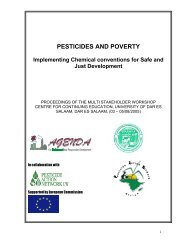Your Daily Poison - Pesticide Action Network UK
Your Daily Poison - Pesticide Action Network UK
Your Daily Poison - Pesticide Action Network UK
Create successful ePaper yourself
Turn your PDF publications into a flip-book with our unique Google optimized e-Paper software.
Gaps in testing<br />
different studies are significantly variable and<br />
the ten-fold uncertainty factor between species<br />
is barely adequate in the case of some<br />
pesticides, for example, chlorpyrifos. In the<br />
case of diuron, there is a ten-fold variability<br />
within studies. For lambda-cyhalothrin, there<br />
can be a three or four-fold variability up to a<br />
30-fold variability, depending on which study is<br />
selected.<br />
There is currently no regulatory mechanism to<br />
ensure that human dose-effect data held by<br />
the National <strong>Poison</strong>s Information Service (and<br />
equivalent organisations internationally) from<br />
human poisonings, are fed into the pesticides<br />
approval process, although PAN <strong>UK</strong> welcomes<br />
new initiatives of ECVAM, which recognises<br />
the critical importance of human data: ‘ …<br />
Validation – the proof that a test accurately<br />
predicts a specific effect in humans – is the<br />
biggest challenge for alternative methods …<br />
One of the 40 or so tests now going through<br />
validation is the new cytotoxicity test to help<br />
replace the animal lethal dose (LD50) test. It<br />
was the first validation study to involve both US<br />
and European groups from the start. It is also<br />
the first to use data from the records at<br />
national poison centres. The predictions of the<br />
in vitro test provided a better match than the<br />
rat LD50 test when compared with the toxicity<br />
information on 42 chemicals listed has having<br />
poisoned people.’ 48<br />
There are serious ethical concerns about<br />
laboratory animal testing, and the inefficiency<br />
and wastefulness of the current system is<br />
referred to in the Prague Declaration: ‘It is<br />
regrettable that commercial pressures and<br />
property rights often stand in the way of<br />
making publicly available the data gathered by<br />
New concern has been expressed recently about shortcomings in the testing regime in<br />
relation to the supposedly non-active ingredients in pesticide formulations. According<br />
to French scientist Gilles-Eric Seralini 49 :<br />
‘Scientific problems do exist in the registration of pesticides today, when chronic<br />
toxicity tests are conducted with the active ingredient alone – which is generally the<br />
case. First of all, chemists from companies may work hard for several years to find the<br />
formulation which best amplified the effects of the active ingredient. This formulation<br />
will allow penetration and stability and/or bioaccumulation of the active ingredients<br />
within plant, fungi or insect cells, for instance, to reach the best toxicity. If there are<br />
any side effects in other animal or human cells, these will be also amplified by<br />
adjuvants, and thus not measured in chronic toxicity tests with the active ingredient<br />
alone. The active compound absorption by skin is generally calculated in the presence<br />
of formulated adjuvants, but this is clearly a short-term study and not sufficient to<br />
detect, for example, endocrine disruption or carcinogenesis, possibly promoted in vivo<br />
by the described synergy. This should even necessitate further care in the use of<br />
formulated products such as glyphosate-based herbicides on tolerant, edible plants.’<br />
16<br />
industrial companies for the purposes of<br />
hazard identification. We propose that the<br />
relevant data from animal testing should be<br />
made publicly available whenever possible.<br />
This would avoid costly duplication of<br />
experiments, and take account of ethical<br />
issues ensuring that the best use can be made<br />
of animal data for the development of<br />
alternative tests.’<br />
Secret practice: human pesticide testing<br />
Over the last year there has been considerable<br />
high level debate initiated in the US about this<br />
issue. There is pressure on the agrochemical<br />
industry globally to conduct these studies ‘to<br />
reduce uncertainty’ because there is increasing<br />
demand for more sophisticated safety<br />
assessment. In the US, since 1996, the Food<br />
Quality Protection Act requires the<br />
Environmental Protection Agency to add an<br />
additional uncertainty factor of between 2 and<br />
10 to account for the special susceptibility of<br />
infants and children to toxic substances, unless<br />
there are data to the contrary. PAN North<br />
America has now launched a campaign with<br />
Earthjustice and the Natural Resources<br />
Defense Council challenging the practice 50 .<br />
Human pesticide testing is unregulated in the<br />
<strong>UK</strong>. For historical reasons it is exempt from<br />
new stringent regulation imposed on<br />
experimental trials of medicinal<br />
pharmaceuticals. However, there is<br />
considerable public concern. The<br />
internationally accepted legal instrument<br />
controlling human pesticide testing is the<br />
Declaration of Helsinki 1964, which introduced<br />
an ethical framework to be applied to all<br />
biomedical research on human beings, to<br />
prevent the reoccurrence of the evils of Nazi<br />
experimentation. Current 51 human pesticide<br />
testing is conducted in complete secrecy within<br />
the private sector, and the lack of scientific and<br />
ethical scrutiny to which trials of<br />
pharmaceutical drugs are subject is a matter of<br />
concern.<br />
<strong>Your</strong> daily poison

















